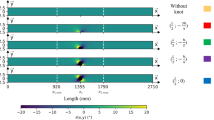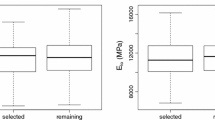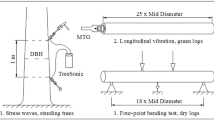Abstract
The aim of this project is to analyse the influence of wood structure of ash timber products — as a result from different growth rates — on their performance, if nondestructive evaluation is applied. To do this, 261 beams have been tested with the method of natural frequency on flexural vibration. The following anatomical and structural parameters have been documented as independent variables on all tested beams: annual ring width, proportion of latewood, ring position, grain orientation, presence or absence of heartwood and other discolourations as well as the positions and dimensions of knots. The values obtained from the nondestructive evaluation have been put into relation with the MOR obtained through final destructive 4-point-bending test of all beams. The influence of the wood structure on this relationship has been analysed either with univariate regressions between single structural parameters and MOR, or including more than one of these structural parameters in multivariate regression models. The regressions between nondestructive parameters and MOR present lower levels of determination than the usual determination levels reported for softwood timber. For the ringporous species ash the influence of the wood structure could be more significant than for the more homogeneous wood structure of coniferous species and, consequently, should be analysed in detail. The main results of this analysis show only minimal influence of the ring structure and of the grain angle on the relationship between nondestructive values and MOR. The presence of heartwood does not influence this relationship. By far the most important parameter is the presence or absence of knots. Different knot parameters were measured and included into the models: KAR and vectorial models of position and dimension of the knots. This detailed measurement of the knots and its inclusion into multiple regression models allow a significant increase of the total level of determination and consequently an improved nondestructive quality assessment of ash timber products. Consequences for the practical application of the results in industrial sawmilling are considered.
Zusammenfassung
Ziel der vorliegenden Untersuchung ist die Analyse des Einflusses der Holzstruktur — als Ergebnis unterschiedlicher Wuchsdynamik — auf die zerstörungsfreie Prüfung von Eschen-Schnittware. 261 Kanthölzer wurden mittels der Methode der Eigenfrequenz bei flexuraler Schwingung getestet. Folgende anatomische und strukturelle Holzmerkmale wurden an allen Proben dokumentiert: Jahrringbreite, Spätholzanteil, Jahrringposition, Faserneigung, Kernholzanteil sowie exakte Positionen und Dimensionen aller Äste. Die Beziehungen zwischen den aus der zerstörungsfreien Prüfung gewonnenen Werten und der in Zerstörungsprüfung (4-Punkt-Biegeversuch) ermittelten Biegefestigkeit wurden untersucht. Der Einfluß der Holzstruktur auf diese Zusammenhänge wurde mit Hilfe von univariaten und multivariaten Regressionsmodellen zwischen den Strukturparametern und der Biegefestigkeit analysiert. Die Holzstruktur des ringporigen Eschenholzes zeigt einen höheren Einfluß auf die Prädiktion der Biegefestigkeit als bei Schnittwaren von Nadelhölzern mit einer homogeneren Struktur. Während die Jahrringstruktur (Jahrringbreite, Spätholzanteil), die Faserneigung und die Verkernung fast keinen direkten Einfluß auf die zerstörungsfreie Bestimmung der Biegefestigkeit zeigen, weisen die Astparameter (KAR, individuelle Astdimensionen) einen deutlichen Einfluß auf. Eine Integration der positionsgewichteten Astparameter in den ausgewählten Regressionsmodellen zur Prädiktion der Biegefestigkeit ermöglicht eine signifikante Erhöhung der Bestimmtheitsmaße.
Similar content being viewed by others
References
Becker, G. 1994: Bestimmung der Festigkeit von Schnittholz durch zerstörngsfreie Prüfung nach dem Prinzip der Eigenfrequenzschwingung — Erfahrungen mit Kantholz aus südwestdeutscher. Douglasienanbauten. 1st European Symposium on Nondestructive Evaluation of Wood. Proceedings Vol. 2: 409–427
Becker, G.; Oliver-Villanueva, J. V.; Ehlebracht, V. 1994: Autkommen und Verwertung von Edellaubholz in Niedersachsen und Nordrhein—Westfalen. Holz-Zentralblatt 120 (Teil I): 742–744; Teil II: 807–811
Boström, L. 1994: Machine strength grading — Comparison of four different systems. Swedish National Testing and Research Institute. Building Technology. SP Report 1994: 49ISBN 91-7848-508-8.
European Commission 1988: Strategien und Maßnahmen der Europäischen Gemeinschaft auf forstwirtschaftlichem Gebiet. Kom (88) 225
Glos, P. 1986: Ermittlung des nationalen und internationalen Standes der maschinellen Holzsortierung. DGfH e.V.—Schlußbericht des Forschungsprojektes BOS021D(B) im Auftrag der Europäischen Kommission. München
Hoffmeyer, P. 1995: Styrkesortering ger mervärde Del 2-Tilgægelig teknik. Laboratoriet for Bygningsmaterialer, Danmarks Tekniske Universitet. Teknisk Rapport 335–1995
Lemmens, J. 1990: Impulse-Excitation-Technique, Symposium of the American Society for Testing and Materials (ASTM) 1989. Kansas-City
Mothe, F.; Marchal, R.; Bucur, V. 1994: Mechanical characterization of LVL from european oak wood by acoustical methods. 1st European Symposium on Nondestructive Evaluation of Wood. Proceedings Vol. 1: 197–206
Negri, M. 1994: Chestnut timber for structural use — A study on grading methods: machine strength grading, ultrasound and free vibrations. 1st European Symposium on Nondestructive Evaluation of Wood. Proceedings Vol. 2: 456–457
Oliver-Villanueva, J. V. 1993: Holzeigenschaften der Esche (Fraxinus excelsior L.) und Variabilität im Hinblick auf Alter Standraum. Dissertation Forstw. Fachbereich der Universität Göttingen. Cuvillier Verlag Göttingen
Perstorper, M. 1994: Strength and stiffness prediction of timber using conventional and dynamic methods. 1st European Symposium on Nondestructive Evaluation of Wood. Proceedings Vol. 2: 321–330
Quer, M.; Oliver-Villanueva, J. V.; Schoppa, F. N.; Becker, G. 1995: Zerstörungsfreies Qualitätskontrollverfahren für die Produktion dynamisch beanspruchter Werkzeugstiele aus Eschenholz. Holz Roh-Werkstoff 53: 229–235
Sauter, U. H. 1992: Technologische Hoizeigenschaften der Douglasie (Pseudotsuga menziesii (Mirb.) France) als Ausprägung unterschiedlicher Wachstumsbedingungen. Dissertation. Forstw. Fachbereich Univ. Freiburg
Author information
Authors and Affiliations
Rights and permissions
About this article
Cite this article
Oliver-Villanueva, J.V., Quer, M. & Becker, G. Influence of structural parameters on the nondestructive evaluation of ash timber (Fraxinus excelsior L.). Holz als Roh-und Werkstoff 54, 109–112 (1996). https://doi.org/10.1007/s001070050148
Issue Date:
DOI: https://doi.org/10.1007/s001070050148




